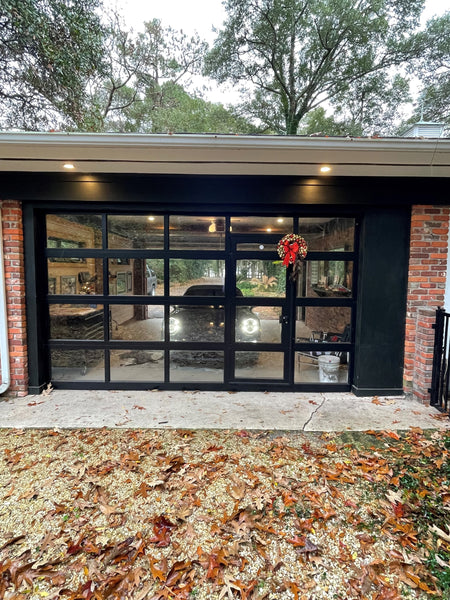
A garage conversion can increase the property's value and add living space. It is simple to do and usually doesn't require planning permission. As long as the garage conversion is compatible with your existing home.
A garage conversion is a cost-effective and flexible option for anyone looking to add an extension, build a bathroom, or make a home office. You don't have to tear down your old garage because it was built on solid foundations.
It is important to use a mixture of materials when converting garages into garden rooms. This makes them both stylish and practical. A garage to garden space can be finished with a contemporary wood effect wall. Additionally, the patterned floor tiles make it more inviting than standard concrete surfaces.

Another garage to garden room conversion uses a more traditional approach, and focuses on brickwork. The architects restored the brickwork and repaired the roof. They also installed insulation, lighting, electrics, and lighting. They also installed doors opening onto the garden.
A detached garage can be used as a garden room if it has a pitched roofing and enough headroom. This will give you more space to create a kitchen or dining area, and also allow you to make the most of your garden.
A garage converted into a garden area is one of most cost-effective ways you can add living space to your house. An excellent conversion costs between PS500 and PS1500 per square metre. This includes structural changes, plumbing, and ventilation.
It's worth speaking with a Resi consultant to discuss your plans for converting your garage or shed into a garden space. Getting an accurate quote takes into account the degree of structural changes that are required, the number of electrics and plumbing fixtures needed, the level of waterproofing and insulation requirements and the overall integration with the rest of your home.

Garden garage conversions are a great choice for homeowners who have limited space and want to make more space for visitors, family members, or guests. In addition, if you're planning on renting your home in the future, you may be able to attract tenants by converting the garage into a habitable room.
The cost of a garage-to-garden room conversion will vary depending on the amount of work involved and the type of furniture used. A professional builder can help determine if your home is suitable for a garage or garden room conversion. The quote will include a cost estimate for the conversion as well as costs for new roofing, walls, flooring, and other related costs.
Always check with your local council to determine if you will need planning permission. Garages are generally considered permitted development and do not require planning permission. However, this is subject to change so it's always a good idea call your local authority before you make any changes.
FAQ
What does it cost to tile a shower?
Do it yourself if possible. A full bathroom remodel is considered an investment. It is worth the investment in high-quality fixtures and materials, especially when you consider the long-term benefits of having a beautiful space that will last for many years.
The right tiles can make all the difference in how your space looks and feels. We have a guide that will help you pick the best tiles for your room, whether you are planning a minor or major renovation.
First, decide which type of flooring you'd like to install. Ceramics, porcelain, stone, and natural wood are common choices. Next, choose a style such as a classic subway tile or a geometric pattern. Select a color palette.
You'll probably want to match the tile to the rest of the room for a large bathroom remodeling job. For example, you might opt for white subway tile in your kitchen or bath and choose darker colors elsewhere.
Next, consider the size of your project. Is it time to update a small powder room? Or would you rather add a walk-in closet to your master suite?
Once you've determined the project's scope, visit local stores and check out samples. You can then get a feel of the product and how it is installed.
Online shopping is a great way to save on porcelain tiles and ceramics. Many sellers offer discounts and free shipping for bulk orders.
How much does it cost to gut and renovate a kitchen completely?
It's possible to wonder how much a home remodel would cost if you are thinking of starting one.
The average kitchen remodel costs between $10,000 and $15,000. You can save money and still improve your space's appearance.
Planning ahead is a great way to cut costs. This includes choosing the right design style and color palette to suit your budget and lifestyle.
Hiring an experienced contractor is another way of cutting costs. Professional tradesmen are familiar with every step of construction, so they won't waste their time trying to figure it out.
You should consider whether to replace or keep existing appliances. Kitchen remodeling projects can cost thousands more if you replace appliances.
It is possible to choose to buy used appliances, rather than buying new ones. Buying used appliances can help you save money because you won't have to pay for installation.
You can also save money by shopping around when buying materials and fixtures. Many stores offer discounts for special occasions like Cyber Monday or Black Friday.
What's the difference between a remodel or a renovation?
Remodeling is the major alteration to a space or a part of a space. A renovation is a minor change to a room or a part of a room. A bathroom remodel, for example, is a major undertaking, while a new sink faucet is minor.
Remodeling entails the replacement of an entire room, or a portion thereof. A renovation is merely changing something in a particular room. Remodeling a kitchen could mean replacing countertops, sinks or appliances. It also involves changing the lighting, colors and accessories. A kitchen remodel could also include painting the walls or installing new lighting fixtures.
What are the most expensive expenses for remodeling a kitchen.
Planning a kitchen renovation can be costly. These include demolition, design fees, permits, materials, contractors, etc. But when we look at these costs individually, they seem pretty small. These costs quickly multiply when they are added up.
Demolition is the most costly cost. This includes removing the old cabinets, appliances, countertops, flooring, etc. The drywall and insulation must then be removed. Finally, replace the items.
Next, you must hire an architect to draw out plans for the space. To ensure your project is compliant with building codes, you will need to pay permits. The final step is to find someone to carry out the actual construction.
Finally, once the job is done, you have to pay the contractor to finish the job. Depending on the size of the job, you could spend between $20,000 to $50,000. This is why it's important to get estimates form multiple contractors before hiring one.
Planning can help you avoid many of these expenses. You might be able negotiate better materials prices or skip some work. You can save money and time if you are clear about what you need to do.
For example, many people try to install their cabinets. Because they don't have professional installation fees, this is a way to save money. They often spend more trying to install cabinets themselves. A job can typically be done in half the time than it would take for you by professionals.
A cheaper way to save money is buying unfinished materials. Pre-finished materials such as cabinets should be inspected before you purchase them. Unfinished materials can be used immediately by you if purchased. And you can always decide to change your mind later if something does not go according to plan.
But sometimes, it isn't worth going through all this hassle. Plan is the best way to save on home improvements.
What is the difference between building a new home and gutting a current one?
Gutting a home removes everything inside a building, including walls, floors, ceilings, plumbing, electrical wiring, appliances, fixtures, etc. Gutting is done when you want to make some modifications before moving in. The cost of gutting a home can be quite expensive due to the complexity involved. The average cost to gut home ranges from $10,000 to $20,000, depending on your job.
A builder builds a house by building it frame by frame. Then, he adds walls and flooring, roofing, windows and doors. This is done usually after purchasing lots. Building a home is normally much less expensive than gutting, costing around $15,000-$30,000.
When it comes down to it, it depends on what you want to do with the space. You'll need to spend more if you plan to gut your home. If you're building your home, however, you don't have to tear everything down and start over. You can build it the way you want it instead of waiting for someone else to come in and tear everything up.
How long does it usually take to remodel your bathroom?
Two weeks is typical for a bathroom remodel. This can vary depending on how large the job is. A few small jobs, like installing a vanity or adding a bathroom stall, can be done in one day. Larger projects, such as removing walls and installing tile floors, and plumbing fixtures, can take several days.
It is a good rule to allow for three days per room. So if you have four bathrooms, you'd need 12 days total.
Statistics
- About 33 percent of people report renovating their primary bedroom to increase livability and overall function. (rocketmortgage.com)
- Attic or basement 10 – 15% (rocketmortgage.com)
- 57%Low-end average cost: $26,214Additional home value: $18,927Return on investment: (rocketmortgage.com)
- $320,976Additional home value: $152,996Return on investment: 48%Mid-range average cost: $156,741Additional home value: $85,672Return on investment: (rocketmortgage.com)
- bathroom5%Siding3 – 5%Windows3 – 4%Patio or backyard2 – (rocketmortgage.com)
External Links
How To
How to remove tile grout from floor tiles
Most people don’t realize they use tile grouting. It is used in sealing joints between tiles. Many different types of grout are available today, each using a specific purpose. We'll show you how we can remove grout from floor tiles.
-
Before you begin this process, it is important to make sure you have all of the necessary tools. You will need a grout cutter and grout scraper.
-
Now you need to start cleaning off any dirt or debris stuck under the tile. You can use the grout cutter to remove grout from the tiles and scrape off any remaining pieces. You should not damage any tiles.
-
After cleaning up all the grout, you can use the grout scraper to remove any remaining grout. You can move on to step 4 if there is no grout left.
-
Now you can get on with the next step. Soak one of your rags in water. Make sure that the rag is completely wet. To ensure that the rag does not absorb water, dry it.
-
Place the wet rag onto the joint where the tile meets the wall. Continue pressing down on the rag until you see the grout begin to fall apart. Slowly pull down on the rag until it is pulled towards you. Continue pulling it backwards and forwards until all the grout has been removed.
-
Continue to repeat steps 4 and 5, until all grout has been removed. Rinse the ragout, and repeat the process if needed.
-
When you are done removing grout, clean the tiles using a damp cloth. Allow to dry completely.